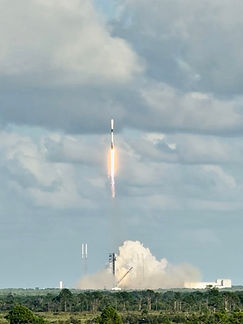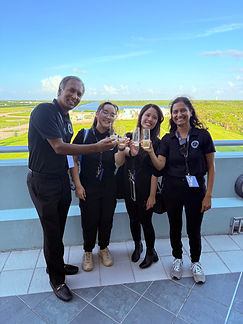Recent News
November 10, 2025
𝗨𝗻𝗶𝘁𝗲𝗱 𝗦𝗲𝗺𝗶𝗰𝗼𝗻𝗱𝘂𝗰𝘁𝗼𝗿𝘀' Second 𝗖𝗿𝘆𝘀𝘁𝗮𝗹 𝗚𝗿𝗼𝘄𝘁𝗵 𝗣𝗮𝘆𝗹𝗼𝗮𝗱 𝗦𝘂𝗰𝗰𝗲𝘀𝘀𝗳𝘂𝗹𝗹𝘆 𝗟𝗮𝘂𝗻𝗰𝗵𝗲𝗱 𝘁𝗼 𝘁𝗵𝗲 𝗜𝗻𝘁𝗲𝗿𝗻𝗮𝘁𝗶𝗼𝗻𝗮𝗹 𝗦𝗽𝗮𝗰𝗲 𝗦𝘁𝗮𝘁𝗶𝗼𝗻 𝗳𝗿𝗼𝗺 𝗖𝗮𝗽𝗲 𝗖𝗮𝗻𝗮𝘃𝗲𝗿𝗮𝗹 𝗼𝗻 𝗡𝗼𝗿𝘁𝗵𝗿𝗼𝗽 𝗚𝗿𝘂𝗺𝗺𝗮𝗻’𝘀 𝗡𝗚-𝟮𝟯 𝗥𝗲𝘀𝘂𝗽𝗽𝗹𝘆 𝗠𝗶𝘀𝘀𝗶𝗼𝗻


United Semiconductors LLC (USLLC) is proud to announce the successful launch of its Mission 2 crystal growth payload to the International Space Station (ISS). This marks a major milestone in advancing semiconductor crystal manufacturing in space. Following the success of Mission 1, which demonstrated the transformative effects of microgravity on semimetal–semiconductor composite crystal growth, Mission 2 aims to further expand the scope and scale of space-based semiconductor manufacturing. The payload—designed, built, and qualified by USLLC—was successfully delivered to orbit and is now safely integrated aboard the ISS. Mission 2 will pursue three key advancements: 1) Shorter on-orbit manufacturing durations, 2) Increased production volumes, and 3) Engineered microstructural control to improve material properties for high-performance semiconductor devices. Crystals grown during Mission 1 have already yielded 2× performance gains and 10× higher device yields compared to current terrestrial technologies. Building on these results, Mission 2 is expected to accelerate the transition toward commercial-scale production in microgravity, setting the stage for sustainable in-space semiconductor manufacturing. According to Dr. Partha Dutta, Chief Technologist at USLLC and Principal Investigator: “The success of Mission 2 marks a defining moment for space-enabled semiconductor technologies. With microgravity providing an unparalleled growth environment, we are witnessing a new frontier in material quality, device yield, and reliability.” Dr. Geeta Rajagopalan, President and CEO of USLLC, added: “This mission validates the vision of a robust commercial space economy in low-Earth orbit. By manufacturing advanced semiconductor materials in space, we are laying the groundwork for U.S. leadership in critical technology sectors—from radiation-hardened space electronics to AI, sensors, and advanced computing.” The Mission 2 investigation is being conducted in NASA’s Solidification Using a Baffle in Sealed Ampoules (SUBSA) furnace, with implementation partners CSS Inc., Redwire Space Technologies, Inc., and Axiom Space. The project is supported by NASA’s In-Space Production Applications (InSPA) program under Contract No. 80JSC022CA005, managed by Mr. Kevin Engelbert, InSPA Portfolio Manager, NASA/JSC.
November 5, 2024
United Semiconductors Crystal Growth Payload Arrives at the ISS Onboard SpX-31


SpaceX-31 launch at NASA’s Kennedy Space Center (left) and United Semiconductors’ core team for the SUBSA-InSPA-SSCug project (right). Images courtesy of United Semiconductors LLC.


Applications of SSC Crystals (left) and a typical morphology of SSC Crystals with semimetal needles embedded in a semiconductor matrix. Images courtesy of United Semiconductors LLC.
November 4th, 2024 marked the dawn of a new era for United Semiconductors LLC (USLLC). The first of its kind semiconductor crystal manufacturing experimental payload headed to the International Space Station (ISS) launched on the SpaceX-31 commercial resupply mission at 9:29 p.m. EDT from NASA’s Kennedy Space Center. In-Space manufacturing leveraging microgravity conditions has numerous technological potentials based on scientific research conducted over the past 5 decades. However, there remains many technical gaps for translating scientific success into large scale manufacturing efforts. Through a NASA funded In-Space Production Applications (InSPA) grant, supplemented by a National Science Foundation (NSF) SBIR funding, USLLC is addressing key challenges and feasibility of microgravity manufacturing. This will pave the path for long term development of critical tools and processes for high throughput production of semiconductor-based materials leveraging the beneficial effects of microgravity. The company plans to deploy crystals manufactured in space for potential use in next generation semiconductor technologies, including autonomous systems, sensing, artificial intelligence, aerospace, and defense components. The use of microgravity is expected to boost performance, yield and reliability of devices fabricated with space manufactured materials. USLLC’s SpX-31 payload is for production of a novel class of Semimetal-Semiconductor Composite Bulk Crystals. The investigation will be conducted in the NASA-owned Solidification Using a Baffle in Sealed Ampoules (SUBSA) furnace. Partners on this investigation include payload implementation partners, Redwire Space Technologies, Inc. and CSS, Inc., Axiom Space and third-party validation partner, AFRL’s Wright Patterson Air Force Base (WPAFB). The learnings generated from this project will lay the groundwork for the development of an in-space manufacturing platform for semiconductors. This will enable a robust commercial space economy in low-Earth orbit (LEO) that will stimulate sustainable non-NASA utilization of future commercial LEO destinations (CLDs) and orbital platforms such as the Axiom Space Commercial Space Station. According to Dr. Partha Dutta, an internationally renowned crystal grower, the principal investigator (PI) of this project and chief technologist at USLLC, “this mission is focused on microgravity enabled semiconductor manufacturing and will leapfrog prior science investigations in the SUBSA furnace to a commercial scale process development on ISS”. USLLC is leveraging its two decades of proven track-record in terrestrial III-V compound semiconductor alloy bulk crystal production and component designs for its microgravity materials development. “Our company has been instrumental in leveraging the InSPA program for critical workforce development (WFD) initiatives for training engineers, technicians and engaging STEM students for the emerging semiconductor industry in alignment with the priorities of the “CHIPS for America” WFD plans” says Dr. Geeta Rajagopalan, President and CEO of United Semiconductors LLC. Key institutions in the WFD include Cal State University Long Beach and Chapman University. A beneficiary of the WFD program, Ms. Candy Dang, a materials engineer and the payload fabrication lead at USLLC, highlights that “the NASA InSPA and NSF programs enable effective engagement of STEM majors into an emerging field of space manufacturing and have been instrumental in job training via hands-on experience in a real-world corporate setting.” USLLC’s WFD activities are focused on women, underserved minorities and veterans. “Being a women owned business with predominantly women workforce, USLLC strives to develop STEM women leaders through a variety of WFD educational platforms” says Dr. Rajagopalan.
